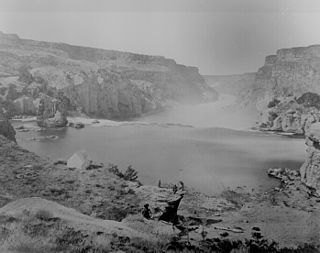
The Geological Exploration of the Fortieth Parallel was a geological survey made by order of the Secretary of War according to acts of Congress of March 2, 1867, and March 3, 1869, under the direction of Brig. and Bvt. Major General A. A. Humphreys, Chief of Engineers, by Clarence King, U. S. geologist. More commonly known as the Fortieth Parallel Survey, the survey conducted field work from 1867 to 1872, exploring the area along the fortieth parallel north from northeastern California, through Nevada, to eastern Wyoming.
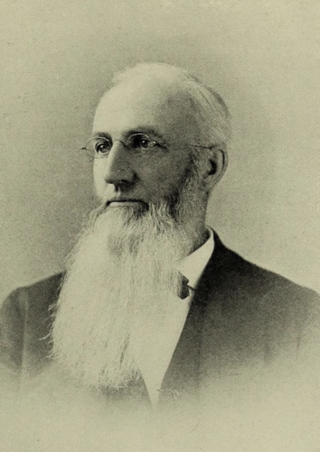
Sereno Watson was an American botanist. Watson was born December 1, 1826 in East Windsor Hill, Connecticut. Graduating from Yale in 1847 in Biology, he drifted through various occupations until, in California, he joined the Clarence King Expedition and eventually became its expedition botanist. Appointed by Asa Gray as assistant in the Gray Herbarium of Harvard University in 1873, he later became its curator, a position he maintained until his death. Watson was elected a Fellow of the American Academy of Arts and Sciences in 1874, and a member of the National Academy of Sciences in 1889. He died March 9, 1892 in Cambridge, Massachusetts.

Glyptopleura marginata is a species of North American plants in the family Asteraceae. The common names for this plant include carveseed, keysia, and crustleaf.
Glyptopleura setulosa, the holy dandelion, is a species of North American plants in the family Asteraceae.

Allium atrorubens is a species of wild onion known by the common name dark red onion. This plant is native to the southwestern United States where it grows in the sandy soils of the Mojave Desert, the Great Basin and higher-elevation deserts in Nevada, eastern California southwestern Utah, northwestern Arizona.

Allium nevadense is a species of wild onion known by the common name Nevada onion. It is native to the western United States where it grows in sand and rocky soil at elevations of 1400–1700 m. The species is widespread in Utah, Nevada and southern Idaho, and has been reported also from southeastern California, northwestern Arizona, western and central Colorado and eastern Oregon.
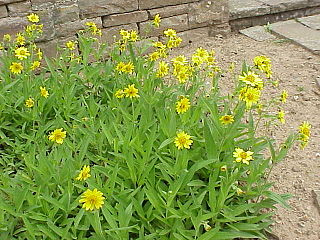
Arnica longifolia is a North American species of arnica in the sunflower family, known by the common names seep-spring arnica, longleaf arnica and spearleaf arnica. This flowering perennial is native to the forests of western Canada and the western United States.

Fimbristylis thermalis is a species of fimbry known by the common name hot springs fimbry. It is native to the southwestern United States and northern Mexico. It has been reported from Baja California, California, Arizona, Nevada, Utah and Coahuila.
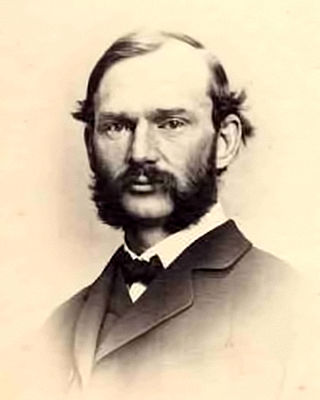
Daniel Cady Eaton was an American botanist and author. After studies at the Rensselaer Institute in Troy and Russell's military school in New Haven, he gained his bachelor's degree at Yale College, then went on to Harvard University, where he studied with Asa Gray. He then went to Yale University's Sheffield Scientific School in 1864, where he was a botany professor and herbarium curator. Eaton is the grandson of Amos Eaton.

Allium bisceptrum, also known as the twincrest onion or aspen onion, is a high elevation plant native to western United States. It is a perennial that thrives under damp and shady conditions or open meadows in California, Arizona, New Mexico, Nevada, Oregon, Washington, Idaho, and Utah.

Toxicoscordion nuttallii is a species of poisonous plant native to the south-central part of the United States.
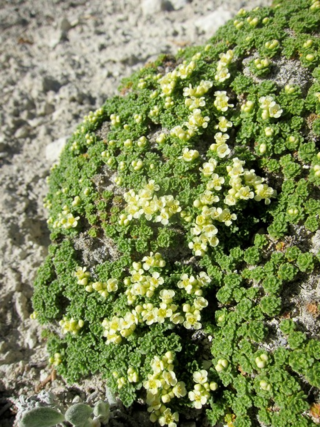
Lepidium nanum, the dwarf pepperweed, is a plant species native to the US states of Nevada and Utah. It is known from four counties in Nevada but only one in Utah. It occurs in open, sunlit areas in the desert, often with gypsum, limestone, quartzite or chalky soils.
Allium bigelovii, the New Mexico wild leek, is a plant species native to Arizona and southwestern New Mexico. It grows on open, gravelly slopes at elevations of 500–1,700 m (1,600–5,600 ft).

Allium brevistylum is a plant species native to the western United States. It grows in meadows and along stream banks high in the mountains of Colorado, Utah, Wyoming, Montana and Idaho, at elevations of 2200–3400 m.
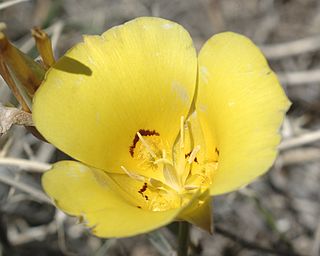
Calochortus aureus is a North American species of flowering plants in the lily family. It is native to the southwestern United States . n Calochortus aureus is a bulb-forming perennial herb producing a single stalk up to 30 cm tall. Flowers are bright lemon-yellow with red or purple splotches on the petals.

Calochortus gunnisonii commonly known as Rocky Mountain mariposa or Gunnison mariposa lily is a North American species of flowering plant in the lily family. It is native to the western United States, primarily in the Rocky Mountains and Black Hills: Arizona, New Mexico, Utah, Colorado, Wyoming, Montana, South Dakota, Washington state (Grant County, northwestern Nebraska and eastern Idaho.
Antennaria marginata is a North American species of flowering plant in the family Asteraceae known by the common name whitemargin pussytoes. It is native to northern Mexico and the southwestern United States.
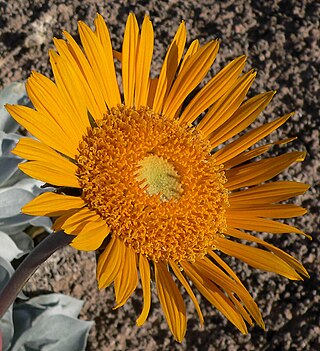
Enceliopsis argophylla, commonly known as the silverleaf sunray, is a North American species of flowering plant in the family Asteraceae. Other common names include nakedstem sunray and naked-stemmed daisy. It is native to the southwestern United States: Arizona, Nevada, and Utah, and can be seen a short distance east of Las Vegas, Nevada.

Erythranthe carsonensis is a species of monkeyflower known by the common name Carson Valley monkeyflower.

Charles Lewis Anderson was an American medical doctor who, in addition to the practice of medicine, made important contributions to fields of natural history, especially botany. Educated in Indiana, he spent most of his professional life in the upper Midwest and West. Many plants collected by him were subsequently named in his honor. He wrote about local natural history, and actively engaged in public service in places where he resided.

















